Exploring Cultural Safety: How Values, Beliefs Shape Healthcare
VerifiedAdded on 2023/06/08
|8
|1835
|263
Essay
AI Summary
This essay explores the concept of cultural safety in healthcare, reflecting on the author's values, beliefs, and behaviors and how they influence cultural safety practices. The author examines values such as integrity, confidentiality, honesty, and teamwork, highlighting their importance in fostering positive patient-professional relationships and ensuring high-quality care. Beliefs, including a belief in personal capability, the necessity of hard work, the power of positive thinking, and the importance of continuous development, are also analyzed for their potential impact on patient care and cultural sensitivity. Furthermore, the author reflects on personal behaviors like cautiousness, a positive attitude, responsibility, and humor, recognizing their role in creating a culturally safe and competent healthcare environment. The essay concludes that continuous learning and experience are essential for enhancing cultural safety and delivering quality healthcare services and this document is available on Desklib with more solved assignments and resources.
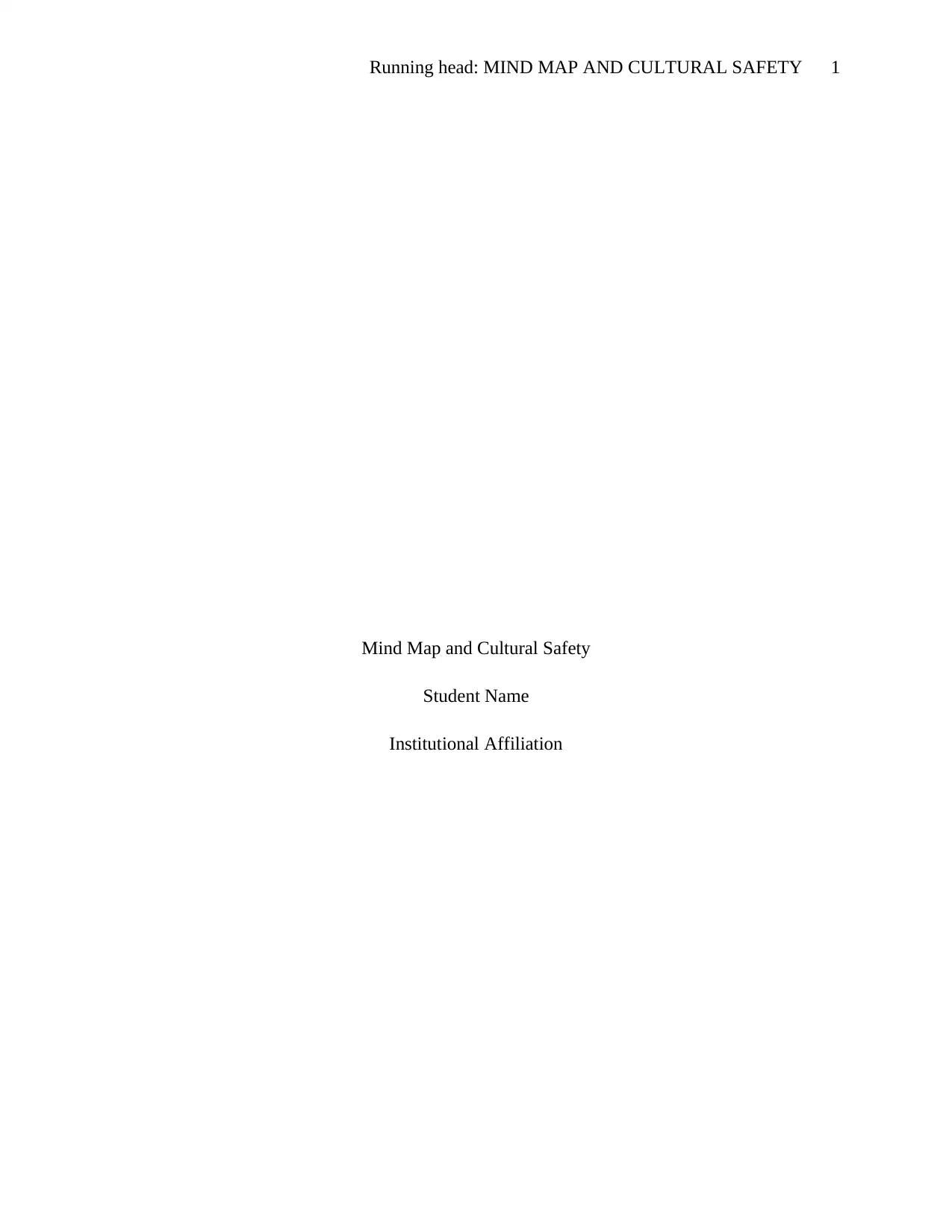
Running head: MIND MAP AND CULTURAL SAFETY 1
Mind Map and Cultural Safety
Student Name
Institutional Affiliation
Mind Map and Cultural Safety
Student Name
Institutional Affiliation
Paraphrase This Document
Need a fresh take? Get an instant paraphrase of this document with our AI Paraphraser
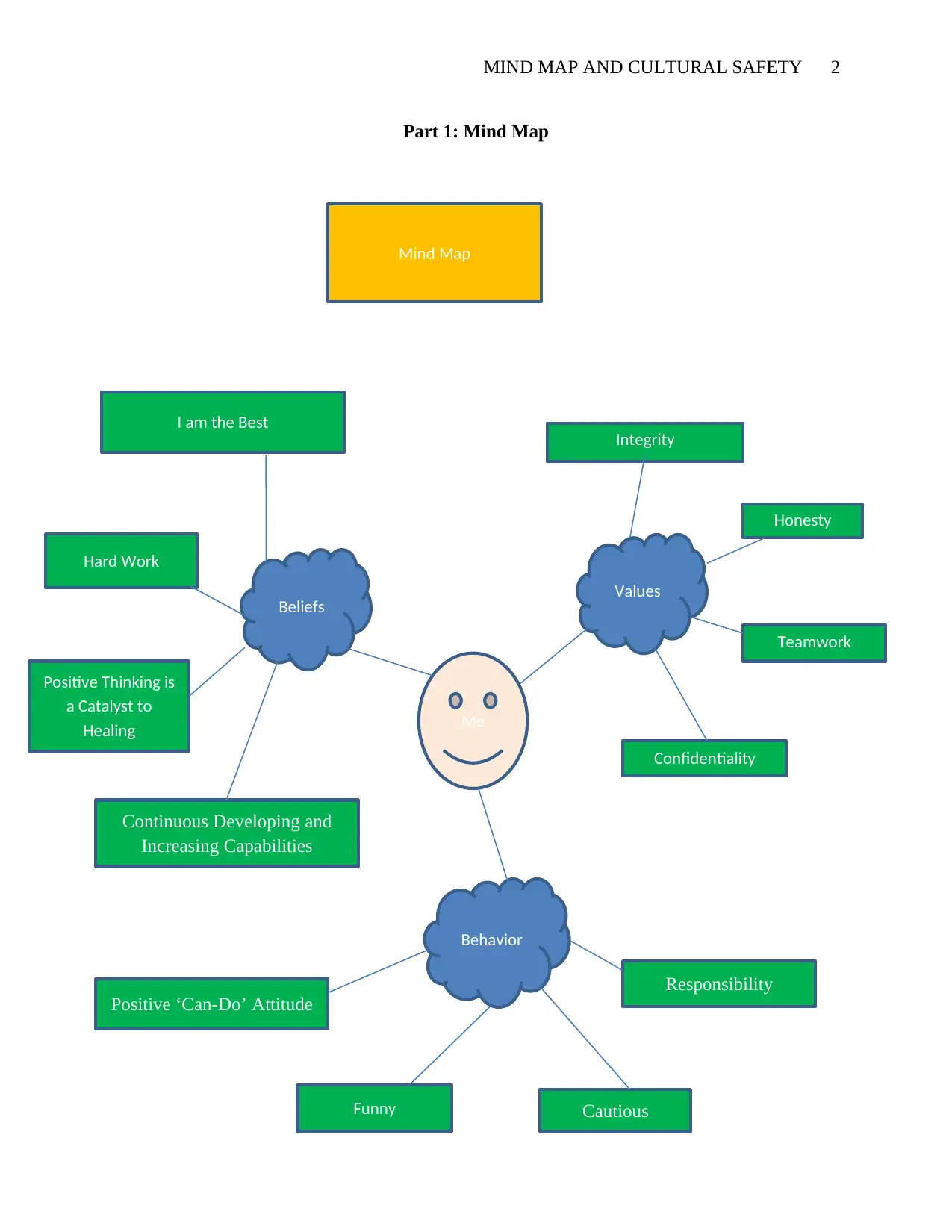
MIND MAP AND CULTURAL SAFETY 2
Part 1: Mind Map
Me
Values
Beliefs
Behavior
Integrity
Honesty
Teamwork
Confidentiality
Mind Map
I am the Best
Hard Work
Positive Thinking is
a Catalyst to
Healing
Continuous Developing and
Increasing Capabilities
Positive ‘Can-Do’ Attitude
Funny Cautious
Responsibility
Part 1: Mind Map
Me
Values
Beliefs
Behavior
Integrity
Honesty
Teamwork
Confidentiality
Mind Map
I am the Best
Hard Work
Positive Thinking is
a Catalyst to
Healing
Continuous Developing and
Increasing Capabilities
Positive ‘Can-Do’ Attitude
Funny Cautious
Responsibility
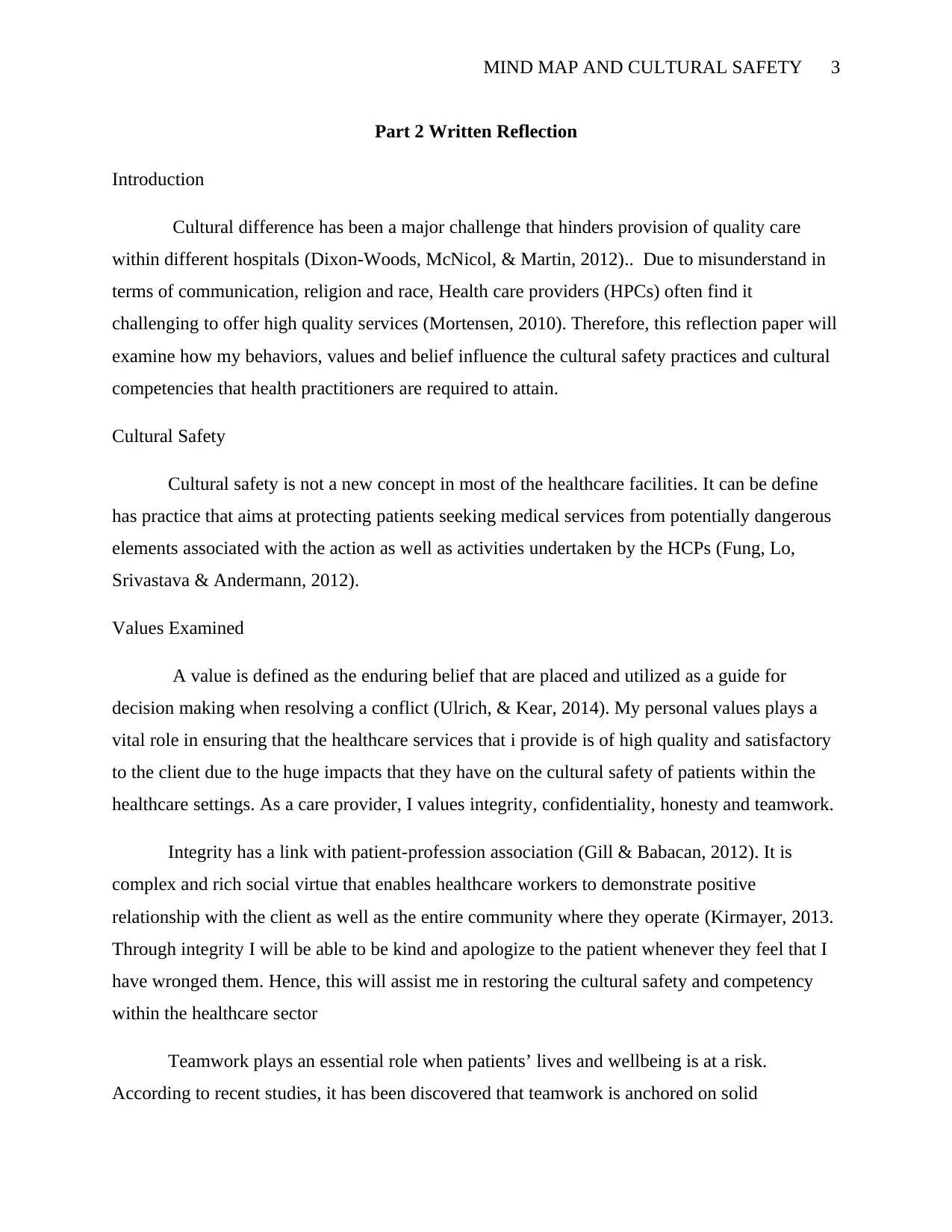
MIND MAP AND CULTURAL SAFETY 3
Part 2 Written Reflection
Introduction
Cultural difference has been a major challenge that hinders provision of quality care
within different hospitals (Dixon-Woods, McNicol, & Martin, 2012).. Due to misunderstand in
terms of communication, religion and race, Health care providers (HPCs) often find it
challenging to offer high quality services (Mortensen, 2010). Therefore, this reflection paper will
examine how my behaviors, values and belief influence the cultural safety practices and cultural
competencies that health practitioners are required to attain.
Cultural Safety
Cultural safety is not a new concept in most of the healthcare facilities. It can be define
has practice that aims at protecting patients seeking medical services from potentially dangerous
elements associated with the action as well as activities undertaken by the HCPs (Fung, Lo,
Srivastava & Andermann, 2012).
Values Examined
A value is defined as the enduring belief that are placed and utilized as a guide for
decision making when resolving a conflict (Ulrich, & Kear, 2014). My personal values plays a
vital role in ensuring that the healthcare services that i provide is of high quality and satisfactory
to the client due to the huge impacts that they have on the cultural safety of patients within the
healthcare settings. As a care provider, I values integrity, confidentiality, honesty and teamwork.
Integrity has a link with patient-profession association (Gill & Babacan, 2012). It is
complex and rich social virtue that enables healthcare workers to demonstrate positive
relationship with the client as well as the entire community where they operate (Kirmayer, 2013.
Through integrity I will be able to be kind and apologize to the patient whenever they feel that I
have wronged them. Hence, this will assist me in restoring the cultural safety and competency
within the healthcare sector
Teamwork plays an essential role when patients’ lives and wellbeing is at a risk.
According to recent studies, it has been discovered that teamwork is anchored on solid
Part 2 Written Reflection
Introduction
Cultural difference has been a major challenge that hinders provision of quality care
within different hospitals (Dixon-Woods, McNicol, & Martin, 2012).. Due to misunderstand in
terms of communication, religion and race, Health care providers (HPCs) often find it
challenging to offer high quality services (Mortensen, 2010). Therefore, this reflection paper will
examine how my behaviors, values and belief influence the cultural safety practices and cultural
competencies that health practitioners are required to attain.
Cultural Safety
Cultural safety is not a new concept in most of the healthcare facilities. It can be define
has practice that aims at protecting patients seeking medical services from potentially dangerous
elements associated with the action as well as activities undertaken by the HCPs (Fung, Lo,
Srivastava & Andermann, 2012).
Values Examined
A value is defined as the enduring belief that are placed and utilized as a guide for
decision making when resolving a conflict (Ulrich, & Kear, 2014). My personal values plays a
vital role in ensuring that the healthcare services that i provide is of high quality and satisfactory
to the client due to the huge impacts that they have on the cultural safety of patients within the
healthcare settings. As a care provider, I values integrity, confidentiality, honesty and teamwork.
Integrity has a link with patient-profession association (Gill & Babacan, 2012). It is
complex and rich social virtue that enables healthcare workers to demonstrate positive
relationship with the client as well as the entire community where they operate (Kirmayer, 2013.
Through integrity I will be able to be kind and apologize to the patient whenever they feel that I
have wronged them. Hence, this will assist me in restoring the cultural safety and competency
within the healthcare sector
Teamwork plays an essential role when patients’ lives and wellbeing is at a risk.
According to recent studies, it has been discovered that teamwork is anchored on solid
⊘ This is a preview!⊘
Do you want full access?
Subscribe today to unlock all pages.

Trusted by 1+ million students worldwide

MIND MAP AND CULTURAL SAFETY 4
communication, there patients together with their families often feels more at ease and satisfied
when they are attended to by a group of HCPs (Gordon, Mendenhall, & O'Connor, 2012).
Therefore, to ensure that there is cultural safety at my workplace, I will encourage teamwork and
togetherness while delivering services
Honesty is a core value to cultural safety in every hospital setting. To ensure that there is
provision of high quality services, HCPs must ensure that they uphold highest standards of
honesty. As an HCP, I will ensure that I promote safety culture in the hospital sector by failing to
submit false claims and stealing from the clients.
Finally, confidentiality is a key value that I will strongly hold for a very long times. The
culture of confidentiality is embedded in my society hence it will play a key role in my
profession. Patients are often entitled to privacy hence revealing their information even to the
colleagues can lead to disruption of cultural safety within the hospital environment (Hrisos, &
Thomson, 2013).
Beliefs
Beliefs are views that are developed and believed to be true by an individual or a group
of people concerning events, concepts or behaviors (Leape et al., 2012).. Has a healthcare
workers to be, I have developed some beliefs that I feel can enhance cultural safety of patients
and lead to quick recovery (Kangasniemi, Vaismoradi, Jasper &Turunen, 2013). Belief that I am
the best was impacted onto me by my math’s teachers since I used to handle challenging
calculations. Reflecting on this, I have realized have carried that belief with me all along and this
is capable of having influence on provision of the health services that I will offer. I have a
feeling that it may help me to save life since I will always try my best. However, I feel that it can
be distrustful since I may go against cultural difference and codes of operation that exist within
the hospital setting. Secondly, I developed my second belief due to the challenges and
experiences that I have passed through while training to become a medic. The journey of
becoming a medic needed hard work and self-belief (Bergner, 2011). Some of my friends
dropped out of school due to various reasons while some changed to other courses. Reflecting on
this, I have realized that hospital setting requires hard work and determination.
communication, there patients together with their families often feels more at ease and satisfied
when they are attended to by a group of HCPs (Gordon, Mendenhall, & O'Connor, 2012).
Therefore, to ensure that there is cultural safety at my workplace, I will encourage teamwork and
togetherness while delivering services
Honesty is a core value to cultural safety in every hospital setting. To ensure that there is
provision of high quality services, HCPs must ensure that they uphold highest standards of
honesty. As an HCP, I will ensure that I promote safety culture in the hospital sector by failing to
submit false claims and stealing from the clients.
Finally, confidentiality is a key value that I will strongly hold for a very long times. The
culture of confidentiality is embedded in my society hence it will play a key role in my
profession. Patients are often entitled to privacy hence revealing their information even to the
colleagues can lead to disruption of cultural safety within the hospital environment (Hrisos, &
Thomson, 2013).
Beliefs
Beliefs are views that are developed and believed to be true by an individual or a group
of people concerning events, concepts or behaviors (Leape et al., 2012).. Has a healthcare
workers to be, I have developed some beliefs that I feel can enhance cultural safety of patients
and lead to quick recovery (Kangasniemi, Vaismoradi, Jasper &Turunen, 2013). Belief that I am
the best was impacted onto me by my math’s teachers since I used to handle challenging
calculations. Reflecting on this, I have realized have carried that belief with me all along and this
is capable of having influence on provision of the health services that I will offer. I have a
feeling that it may help me to save life since I will always try my best. However, I feel that it can
be distrustful since I may go against cultural difference and codes of operation that exist within
the hospital setting. Secondly, I developed my second belief due to the challenges and
experiences that I have passed through while training to become a medic. The journey of
becoming a medic needed hard work and self-belief (Bergner, 2011). Some of my friends
dropped out of school due to various reasons while some changed to other courses. Reflecting on
this, I have realized that hospital setting requires hard work and determination.
Paraphrase This Document
Need a fresh take? Get an instant paraphrase of this document with our AI Paraphraser
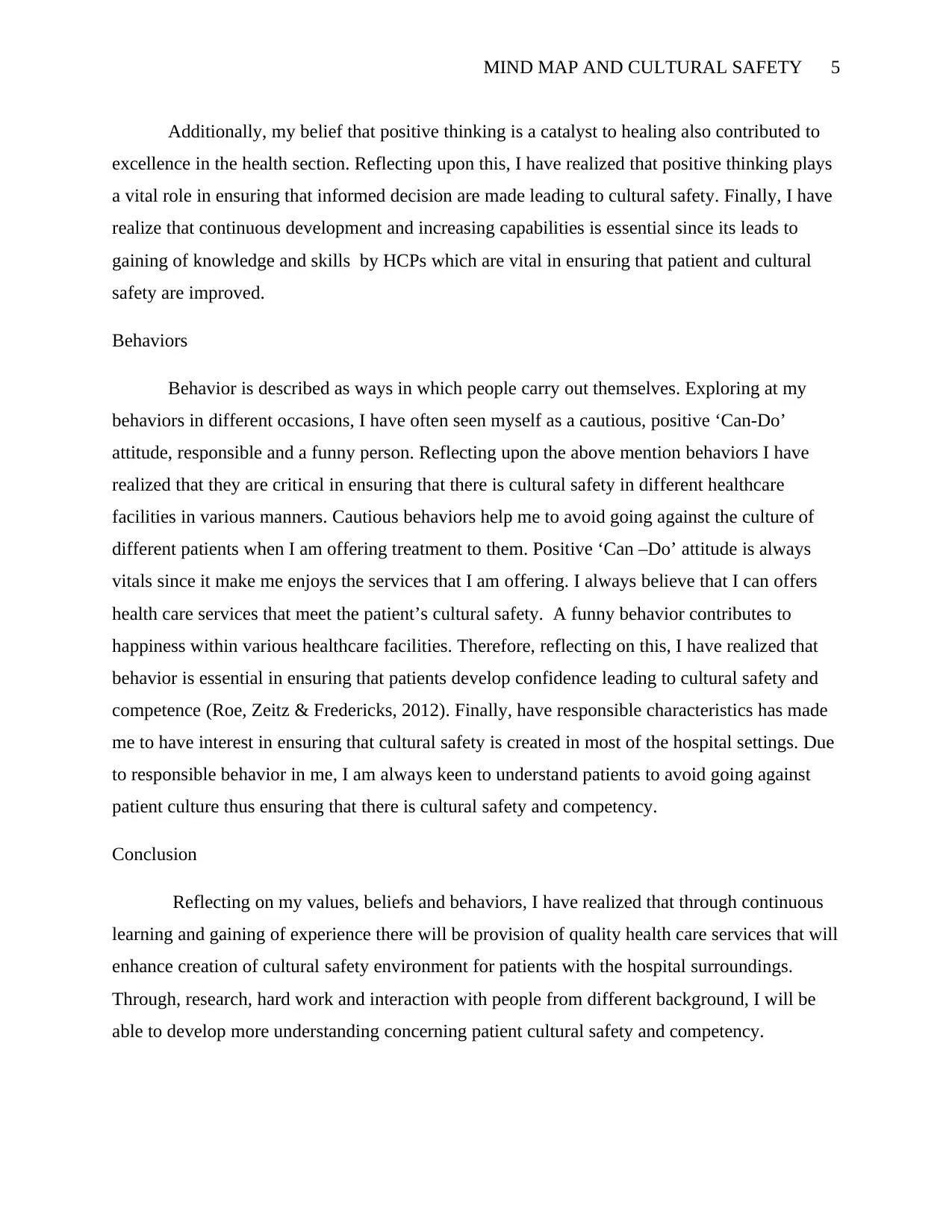
MIND MAP AND CULTURAL SAFETY 5
Additionally, my belief that positive thinking is a catalyst to healing also contributed to
excellence in the health section. Reflecting upon this, I have realized that positive thinking plays
a vital role in ensuring that informed decision are made leading to cultural safety. Finally, I have
realize that continuous development and increasing capabilities is essential since its leads to
gaining of knowledge and skills by HCPs which are vital in ensuring that patient and cultural
safety are improved.
Behaviors
Behavior is described as ways in which people carry out themselves. Exploring at my
behaviors in different occasions, I have often seen myself as a cautious, positive ‘Can-Do’
attitude, responsible and a funny person. Reflecting upon the above mention behaviors I have
realized that they are critical in ensuring that there is cultural safety in different healthcare
facilities in various manners. Cautious behaviors help me to avoid going against the culture of
different patients when I am offering treatment to them. Positive ‘Can –Do’ attitude is always
vitals since it make me enjoys the services that I am offering. I always believe that I can offers
health care services that meet the patient’s cultural safety. A funny behavior contributes to
happiness within various healthcare facilities. Therefore, reflecting on this, I have realized that
behavior is essential in ensuring that patients develop confidence leading to cultural safety and
competence (Roe, Zeitz & Fredericks, 2012). Finally, have responsible characteristics has made
me to have interest in ensuring that cultural safety is created in most of the hospital settings. Due
to responsible behavior in me, I am always keen to understand patients to avoid going against
patient culture thus ensuring that there is cultural safety and competency.
Conclusion
Reflecting on my values, beliefs and behaviors, I have realized that through continuous
learning and gaining of experience there will be provision of quality health care services that will
enhance creation of cultural safety environment for patients with the hospital surroundings.
Through, research, hard work and interaction with people from different background, I will be
able to develop more understanding concerning patient cultural safety and competency.
Additionally, my belief that positive thinking is a catalyst to healing also contributed to
excellence in the health section. Reflecting upon this, I have realized that positive thinking plays
a vital role in ensuring that informed decision are made leading to cultural safety. Finally, I have
realize that continuous development and increasing capabilities is essential since its leads to
gaining of knowledge and skills by HCPs which are vital in ensuring that patient and cultural
safety are improved.
Behaviors
Behavior is described as ways in which people carry out themselves. Exploring at my
behaviors in different occasions, I have often seen myself as a cautious, positive ‘Can-Do’
attitude, responsible and a funny person. Reflecting upon the above mention behaviors I have
realized that they are critical in ensuring that there is cultural safety in different healthcare
facilities in various manners. Cautious behaviors help me to avoid going against the culture of
different patients when I am offering treatment to them. Positive ‘Can –Do’ attitude is always
vitals since it make me enjoys the services that I am offering. I always believe that I can offers
health care services that meet the patient’s cultural safety. A funny behavior contributes to
happiness within various healthcare facilities. Therefore, reflecting on this, I have realized that
behavior is essential in ensuring that patients develop confidence leading to cultural safety and
competence (Roe, Zeitz & Fredericks, 2012). Finally, have responsible characteristics has made
me to have interest in ensuring that cultural safety is created in most of the hospital settings. Due
to responsible behavior in me, I am always keen to understand patients to avoid going against
patient culture thus ensuring that there is cultural safety and competency.
Conclusion
Reflecting on my values, beliefs and behaviors, I have realized that through continuous
learning and gaining of experience there will be provision of quality health care services that will
enhance creation of cultural safety environment for patients with the hospital surroundings.
Through, research, hard work and interaction with people from different background, I will be
able to develop more understanding concerning patient cultural safety and competency.
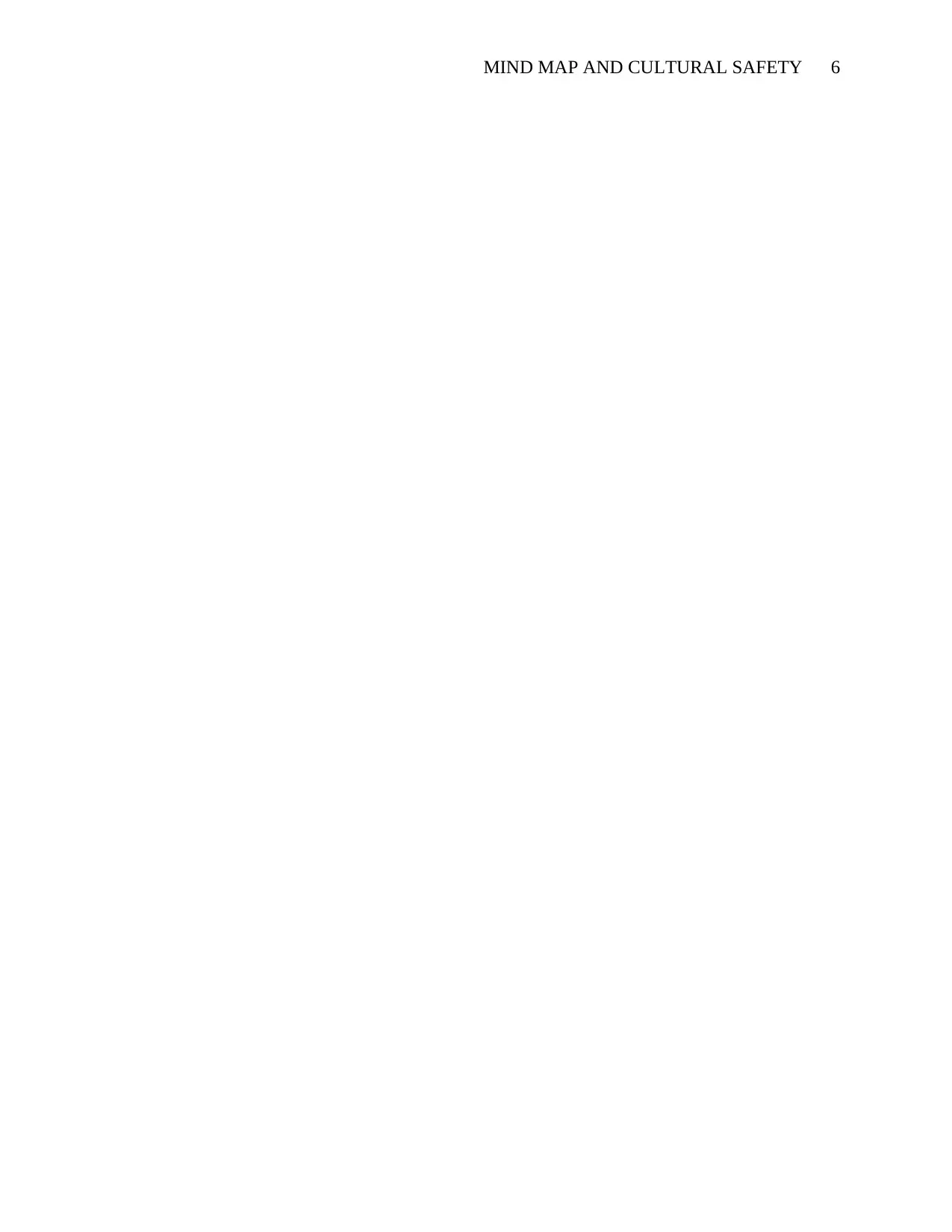
MIND MAP AND CULTURAL SAFETY 6
⊘ This is a preview!⊘
Do you want full access?
Subscribe today to unlock all pages.

Trusted by 1+ million students worldwide

MIND MAP AND CULTURAL SAFETY 7
References
Bergner, R. (2011). What is behavior? And so what? New Ideas in Psychology, 29(2), 147- 155.
Dixon-Woods, M., McNicol, S., & Martin, G. (2012). Ten challenges in improving quality in
healthcare: lessons from the Health Foundation's programme evaluations and relevant
literature. BMJ Qual Saf, bmjqs-2011.
Fung, K., Lo, H. T., Srivastava, R., & Andermann, L. (2012). Organizational cultural
competence consultation to a mental health institution. Transcultural Psychiatry, 49(2),
165-184.
Gill, G. K., & Babacan, H. (2012). Developing a cultural responsiveness framework in
healthcare systems: an Australian example. Diversity & Equality in Health & Care, 9(1).
Gordon, S., Mendenhall, P., & O'Connor, B. B. (2012). Beyond the checklist: What else health
care can learn from aviation teamwork and safety. Cornell University Press. 2(4)
Hrisos, S., & Thomson, R. (2013). Seeing it from both sides: do approaches to involving patients
in improving their safety risk damaging the trust between patients and healthcare
professionals? An interview study. PLoS One, 8(11), e80759.
Kangasniemi, M., Vaismoradi, M., Jasper, M., & Turunen, H. (2013). Ethical issues in patient
safety: implications for nursing management. Nursing ethics, 20(8), 904-916.
Kirmayer, L. J. (2013). Embracing uncertainty as a path to competence: Cultural safety,
empathy, and alterity in clinical training. Culture, Medicine, and Psychiatry, 37(2), 365-
372.
Leape, L. L., Shore, M. F., Dienstag, J. L., Mayer, R. J., Edgman-Levitan, S., Meyer, G. S., &
Healy, G. B. (2012). Perspective: A Culture of Respect, Part 1 The Nature and Causes of
Disrespectful Behavior by Physicians. Academic medicine, 87(7), 845-852.
Mortensen, A. (2010). Cultural safety: Does the theory work in practice for culturally and
linguistically diverse groups? Nursing Praxis in New Zealand, 26(3), 6-16
Roe, Y. L., Zeitz, C. J., & Fredericks, B. (2012). Study protocol: establishing good relationships
between patients and health care providers while providing cardiac care. Exploring how
patient-clinician engagement contributes to health disparities between indigenous and
non-indigenous Australians in South Australia. BMC health services research, 12(1),
397.
References
Bergner, R. (2011). What is behavior? And so what? New Ideas in Psychology, 29(2), 147- 155.
Dixon-Woods, M., McNicol, S., & Martin, G. (2012). Ten challenges in improving quality in
healthcare: lessons from the Health Foundation's programme evaluations and relevant
literature. BMJ Qual Saf, bmjqs-2011.
Fung, K., Lo, H. T., Srivastava, R., & Andermann, L. (2012). Organizational cultural
competence consultation to a mental health institution. Transcultural Psychiatry, 49(2),
165-184.
Gill, G. K., & Babacan, H. (2012). Developing a cultural responsiveness framework in
healthcare systems: an Australian example. Diversity & Equality in Health & Care, 9(1).
Gordon, S., Mendenhall, P., & O'Connor, B. B. (2012). Beyond the checklist: What else health
care can learn from aviation teamwork and safety. Cornell University Press. 2(4)
Hrisos, S., & Thomson, R. (2013). Seeing it from both sides: do approaches to involving patients
in improving their safety risk damaging the trust between patients and healthcare
professionals? An interview study. PLoS One, 8(11), e80759.
Kangasniemi, M., Vaismoradi, M., Jasper, M., & Turunen, H. (2013). Ethical issues in patient
safety: implications for nursing management. Nursing ethics, 20(8), 904-916.
Kirmayer, L. J. (2013). Embracing uncertainty as a path to competence: Cultural safety,
empathy, and alterity in clinical training. Culture, Medicine, and Psychiatry, 37(2), 365-
372.
Leape, L. L., Shore, M. F., Dienstag, J. L., Mayer, R. J., Edgman-Levitan, S., Meyer, G. S., &
Healy, G. B. (2012). Perspective: A Culture of Respect, Part 1 The Nature and Causes of
Disrespectful Behavior by Physicians. Academic medicine, 87(7), 845-852.
Mortensen, A. (2010). Cultural safety: Does the theory work in practice for culturally and
linguistically diverse groups? Nursing Praxis in New Zealand, 26(3), 6-16
Roe, Y. L., Zeitz, C. J., & Fredericks, B. (2012). Study protocol: establishing good relationships
between patients and health care providers while providing cardiac care. Exploring how
patient-clinician engagement contributes to health disparities between indigenous and
non-indigenous Australians in South Australia. BMC health services research, 12(1),
397.
Paraphrase This Document
Need a fresh take? Get an instant paraphrase of this document with our AI Paraphraser
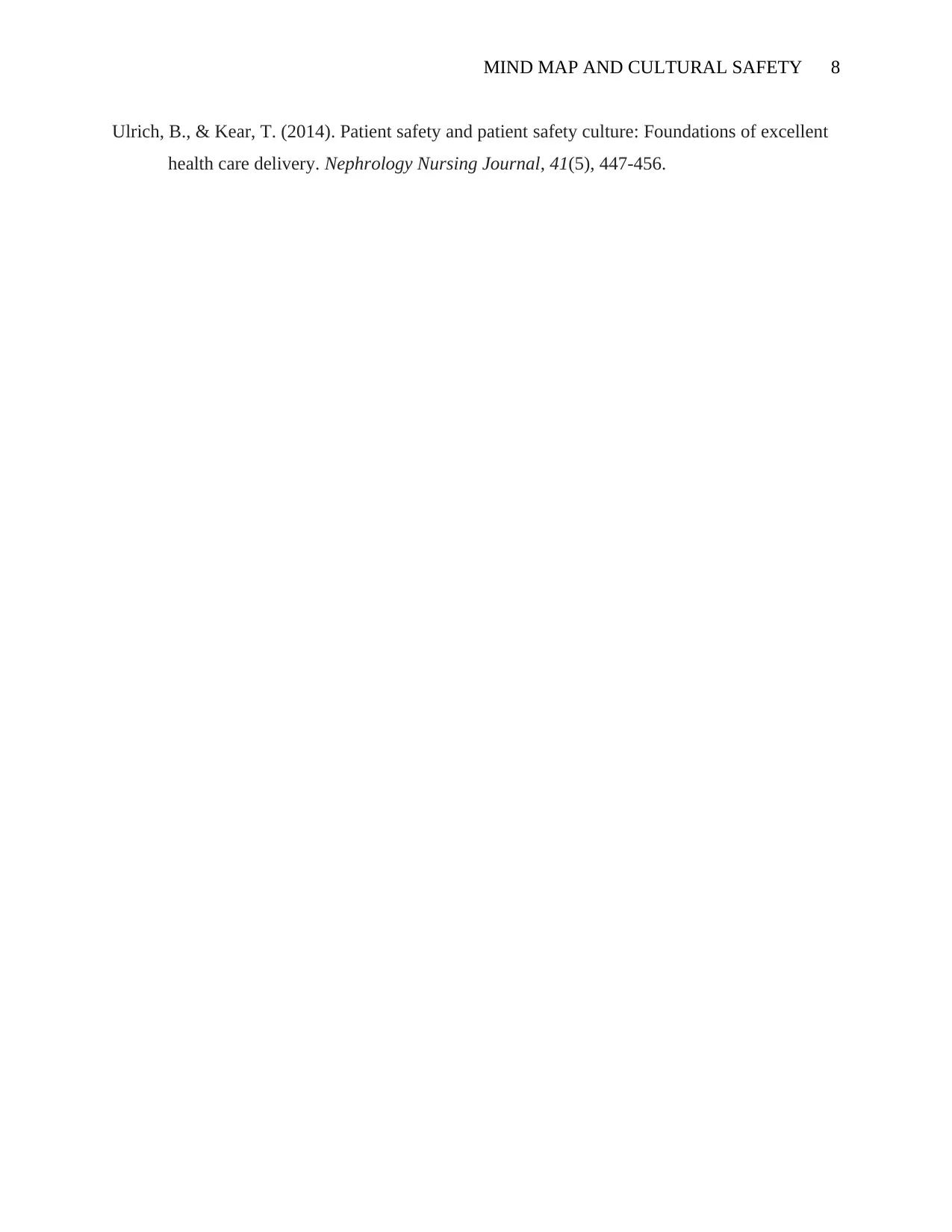
MIND MAP AND CULTURAL SAFETY 8
Ulrich, B., & Kear, T. (2014). Patient safety and patient safety culture: Foundations of excellent
health care delivery. Nephrology Nursing Journal, 41(5), 447-456.
Ulrich, B., & Kear, T. (2014). Patient safety and patient safety culture: Foundations of excellent
health care delivery. Nephrology Nursing Journal, 41(5), 447-456.
1 out of 8
Related Documents
Your All-in-One AI-Powered Toolkit for Academic Success.
+13062052269
info@desklib.com
Available 24*7 on WhatsApp / Email
![[object Object]](/_next/static/media/star-bottom.7253800d.svg)
Unlock your academic potential
Copyright © 2020–2025 A2Z Services. All Rights Reserved. Developed and managed by ZUCOL.





